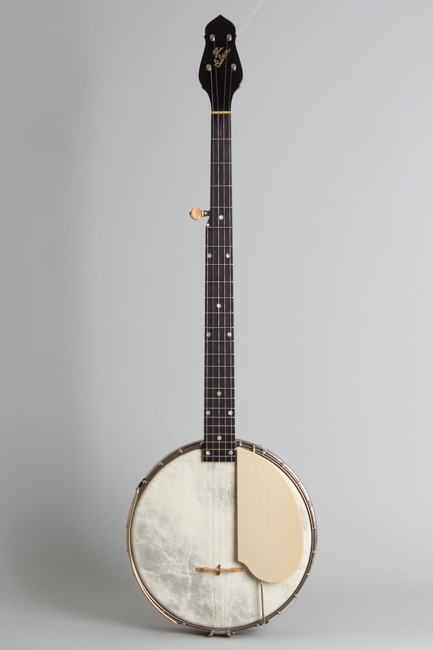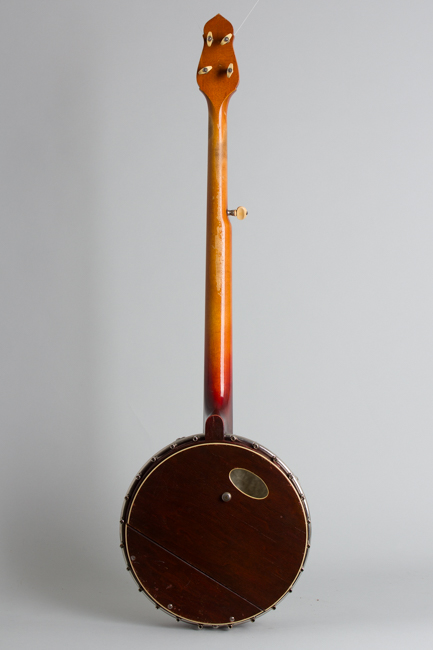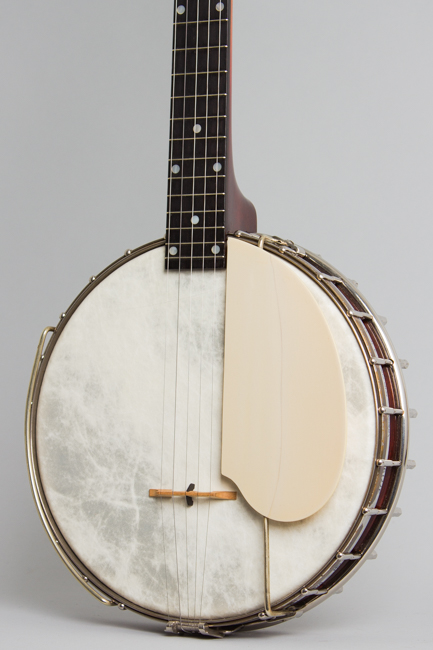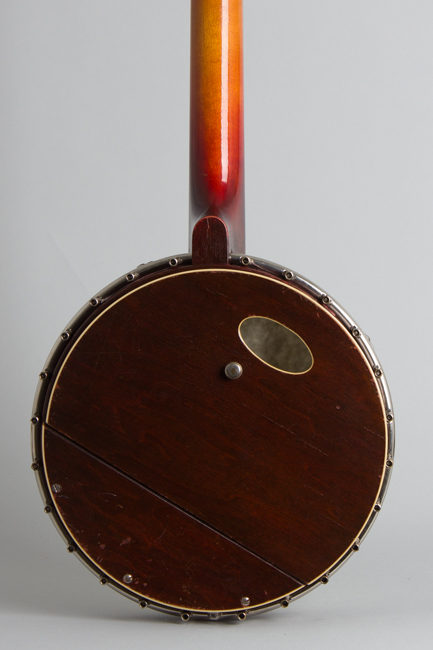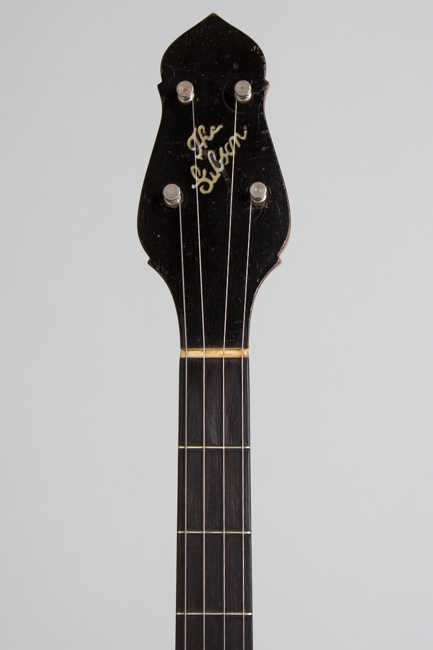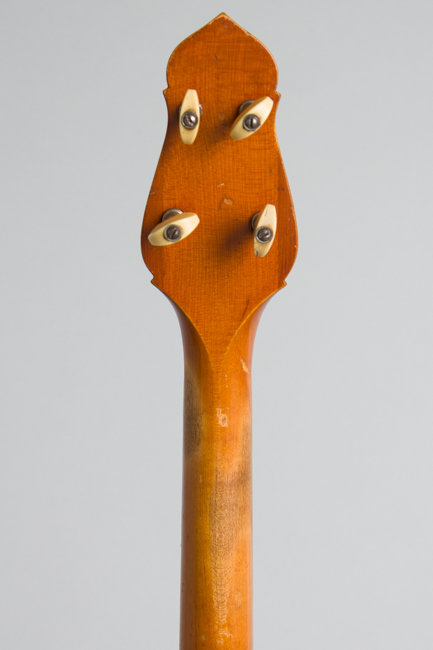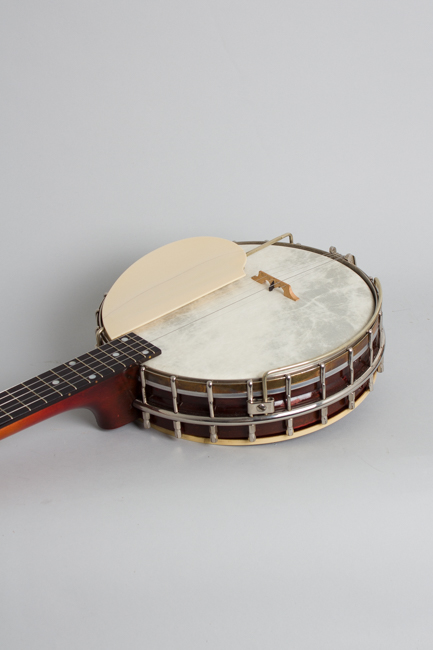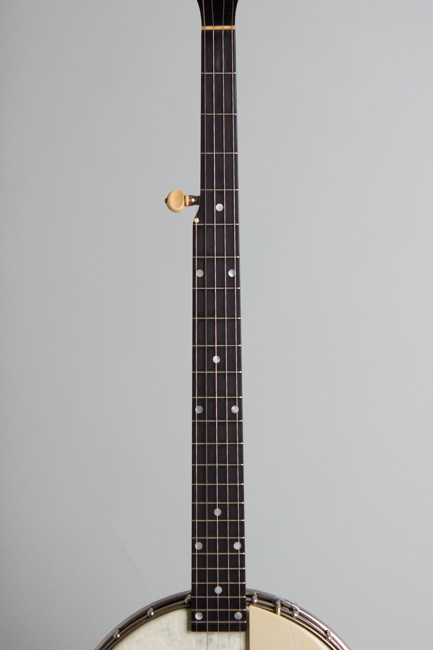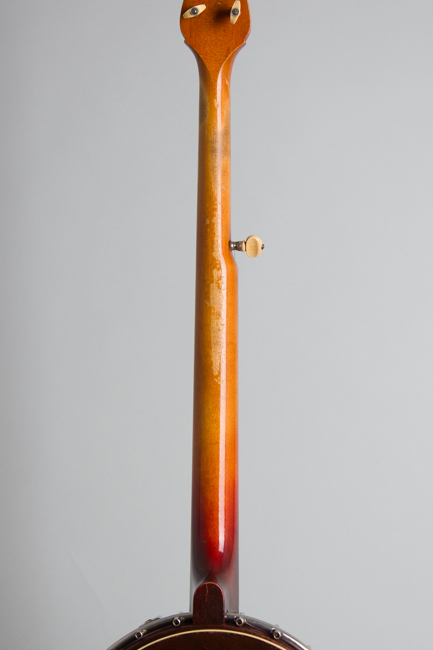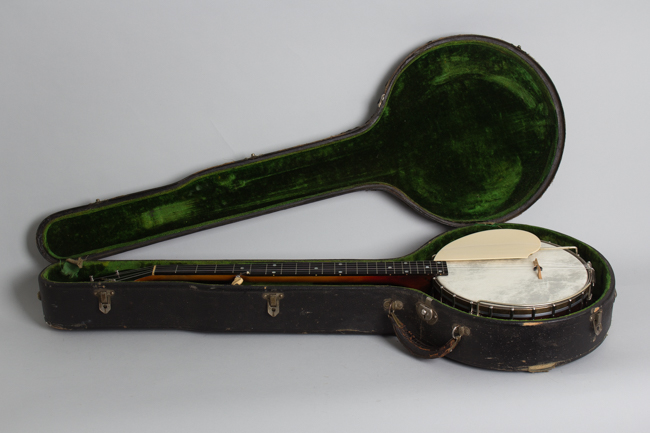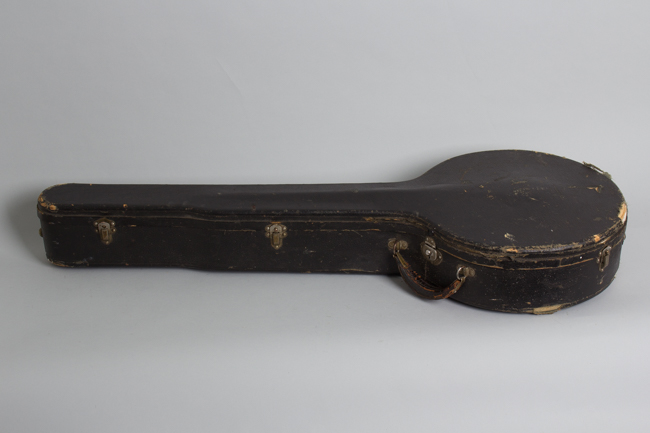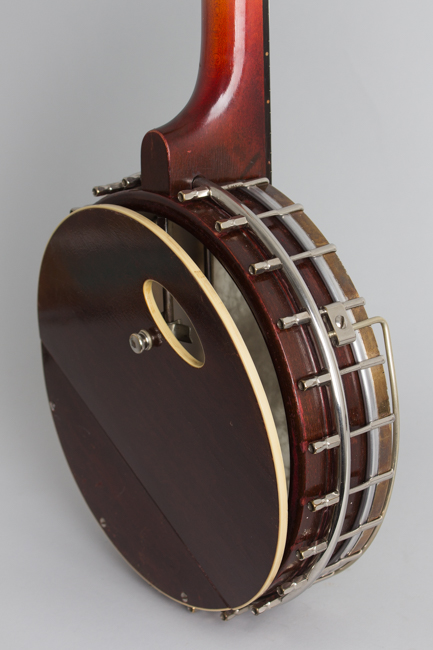Gibson RB-3 Trapdoor 5 String Resonator Banjo (1924)
Gibson RB-3 Trapdoor Model 5 String Resonator Banjo (1924), made in Kalamazoo, Michigan, serial # 11085A-25, shaded maple finish, laminated maple rim; maple neck with ebony fingerboard, period black hard shell case.
Here's an instrument rare enough we've actually only seen two in 25+ years: an original five-string Gibson banjo from the "trap-door" era. While 5-string "Regular Banjos" appear on Gibson's price lists of the time, the company thought so little of their commercial potential they were rarely even pictured in the special Mastertone banjo brochures, though they did make the 1925 catalog. Mandolin banjos get the most attention but even the cello banjo gets more advertising space!
It is not known how many of these "trap door" RB's were produced in the early-mid 1920s but it would be a miniscule number compared to the various other types. Although Gibson claimed "for solo work strung with gut or steel strings the regular of five-string banjo will never be excelled" so few were built compared to tenors and mandolin and even guitar banjos that they hardly ever surface today.
This RB-3 has all the Mastertone features of the era, structurally the same but with less decoration than the Style 4. The laminated maple rim is finished in dark brown; the tube hook/nut bearing used on this banjo would become half of the "tube and plate" flange system in 1925 when the "plate" flange was added. The quirky signature trap door resonator (which Gibson called the "Tone Projector") covers the bottom of the rim; this is bound in ivoroid and hinged in the middle. The upper half of the plate can be licked open or closed to "increase the banjo piquancy" as Gibson put it; it actually accts something like a monitor directing sound right at the player's face!
The tone ring is the Lloyd Loar-designed ball-bearing "Full-floating, Non Friction Tone Tube", which persisted into the early resonator-and-flange Mastertone era through 1927. The banjo also features the then-new Gibson dual co-coordinator rod system for adjusting the neck angle which has since become the world standard. Inside the rim is a gold "Gibson Guarantee" label and the impressed factory order number, which is in a special "A-suffix" series used only in 1924.
the neck is one-piece maple with an unbound, dot inlaid ebony fingerboard. The heel is shaded darker, blending into an ambered natural finish on the rest of the neck. There is no adjustable truss rod fitted, a quirk of pre-1925 Gibson banjos compared to the rest of the line. The "Moccasin head" shaped peghead is unbound but does have a pearl "The Gibson" logo. The tuners are non-geared, straight shaft friction pegs instead of the guitar-style machines Gibson usually employed, probably in a nod to the tastes of traditional banjo players.
Gibson's January 1925 price list offers the RB-3 at $95 (plus $20 for the case) which was $5 more than the TB-3 tenor. Few of the rural performers still using 5-string instruments could afford this price, while the remaining top pro 5-string vaudeville performers were usually seen with Fairbanks/Vega instruments or the then-new Bacon & Day line. By modern 5-string standards this is beautiful if rather unusual sounding banjo, with a pronounced midrange ring, a sweeter tone than many 5-strings and a definite "Old Timey" quality. It is light and handy with the smaller rim and plays superbly. While a far cry from the typical Gibson Bluegrass banjo this is an extremely rare and fascinating instrument in its own right, a fabulous piece of Gibson history and a handy and fun instrument to play.
Overall length is 36 1/8 in. (91.8 cm.), 10 5/8 in. (27 cm.) diameter head, and 3 in. (7.6 cm.) in depth, measured at side of rim. Scale length is 26 1/2 in. (673 mm.). Width of nut is 1 1/8 in. (29 mm.).
This is a slightly worn-in but nicely unmodified banjo, showing some general wear overall. The back of the neck shows the most noticeable wear, down to the wood in the first position and also along the spine to around the 10th fret position. The rest of the finish shows checking, dings and dents but no other large worn-away spots.
All the hardware remains original including the complete set of hooks and nuts and the unique tailpiece. For some reason there is a decent amount of plating loss to the hoop, less to the remaining hardware. The decorative tailpiece cover is included but one of the metal side flanges is detached so it does not mount to the base. The optional original armrest and pickguard are mounted; the celluloid guard was cracked through the middle and solidly but visibly repaired.
The fingerboard and original thin-wire frets show minor wear but still play fine. The neck is not *absolutely* perfectly straight but pretty close and fully playable for a 5-string. The banjo is set up with a newer bridge and a Fiberskyn style head and is a quirky and delightful instrument, pretty unique as "regular" banjos go. It is complete in what appears to be an original period correct green-lined HSC although it is designed for a slightly larger rim; based on the internal wear the banjo looks to have always been in this case. Overall this remains a really cool century old piece of Gibson history, the early beginnings of the company's now celebrated involvement with the five-string banjo and something you just don't see every day! Overall Very Good + Condition.
Here's an instrument rare enough we've actually only seen two in 25+ years: an original five-string Gibson banjo from the "trap-door" era. While 5-string "Regular Banjos" appear on Gibson's price lists of the time, the company thought so little of their commercial potential they were rarely even pictured in the special Mastertone banjo brochures, though they did make the 1925 catalog. Mandolin banjos get the most attention but even the cello banjo gets more advertising space!
It is not known how many of these "trap door" RB's were produced in the early-mid 1920s but it would be a miniscule number compared to the various other types. Although Gibson claimed "for solo work strung with gut or steel strings the regular of five-string banjo will never be excelled" so few were built compared to tenors and mandolin and even guitar banjos that they hardly ever surface today.
This RB-3 has all the Mastertone features of the era, structurally the same but with less decoration than the Style 4. The laminated maple rim is finished in dark brown; the tube hook/nut bearing used on this banjo would become half of the "tube and plate" flange system in 1925 when the "plate" flange was added. The quirky signature trap door resonator (which Gibson called the "Tone Projector") covers the bottom of the rim; this is bound in ivoroid and hinged in the middle. The upper half of the plate can be licked open or closed to "increase the banjo piquancy" as Gibson put it; it actually accts something like a monitor directing sound right at the player's face!
The tone ring is the Lloyd Loar-designed ball-bearing "Full-floating, Non Friction Tone Tube", which persisted into the early resonator-and-flange Mastertone era through 1927. The banjo also features the then-new Gibson dual co-coordinator rod system for adjusting the neck angle which has since become the world standard. Inside the rim is a gold "Gibson Guarantee" label and the impressed factory order number, which is in a special "A-suffix" series used only in 1924.
the neck is one-piece maple with an unbound, dot inlaid ebony fingerboard. The heel is shaded darker, blending into an ambered natural finish on the rest of the neck. There is no adjustable truss rod fitted, a quirk of pre-1925 Gibson banjos compared to the rest of the line. The "Moccasin head" shaped peghead is unbound but does have a pearl "The Gibson" logo. The tuners are non-geared, straight shaft friction pegs instead of the guitar-style machines Gibson usually employed, probably in a nod to the tastes of traditional banjo players.
Gibson's January 1925 price list offers the RB-3 at $95 (plus $20 for the case) which was $5 more than the TB-3 tenor. Few of the rural performers still using 5-string instruments could afford this price, while the remaining top pro 5-string vaudeville performers were usually seen with Fairbanks/Vega instruments or the then-new Bacon & Day line. By modern 5-string standards this is beautiful if rather unusual sounding banjo, with a pronounced midrange ring, a sweeter tone than many 5-strings and a definite "Old Timey" quality. It is light and handy with the smaller rim and plays superbly. While a far cry from the typical Gibson Bluegrass banjo this is an extremely rare and fascinating instrument in its own right, a fabulous piece of Gibson history and a handy and fun instrument to play.
Overall length is 36 1/8 in. (91.8 cm.), 10 5/8 in. (27 cm.) diameter head, and 3 in. (7.6 cm.) in depth, measured at side of rim. Scale length is 26 1/2 in. (673 mm.). Width of nut is 1 1/8 in. (29 mm.).
This is a slightly worn-in but nicely unmodified banjo, showing some general wear overall. The back of the neck shows the most noticeable wear, down to the wood in the first position and also along the spine to around the 10th fret position. The rest of the finish shows checking, dings and dents but no other large worn-away spots.
All the hardware remains original including the complete set of hooks and nuts and the unique tailpiece. For some reason there is a decent amount of plating loss to the hoop, less to the remaining hardware. The decorative tailpiece cover is included but one of the metal side flanges is detached so it does not mount to the base. The optional original armrest and pickguard are mounted; the celluloid guard was cracked through the middle and solidly but visibly repaired.
The fingerboard and original thin-wire frets show minor wear but still play fine. The neck is not *absolutely* perfectly straight but pretty close and fully playable for a 5-string. The banjo is set up with a newer bridge and a Fiberskyn style head and is a quirky and delightful instrument, pretty unique as "regular" banjos go. It is complete in what appears to be an original period correct green-lined HSC although it is designed for a slightly larger rim; based on the internal wear the banjo looks to have always been in this case. Overall this remains a really cool century old piece of Gibson history, the early beginnings of the company's now celebrated involvement with the five-string banjo and something you just don't see every day! Overall Very Good + Condition.
